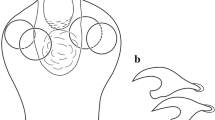Abstract
Post mortem examination of a spot-billed pelican (Pelecanus philippensis) revealed the presence of numerous anisakid nematodes in the proventriculus. The nematodes were processed in lactophenol as temporary mounts and were identified as Contracaecum rudolphii Hartwich, 1964 based on micrometry and morphological description of the anterior end, the sinuous uterus with sub globular thick-shelled eggs in female parasite and the tips of the spicules in male parasite. This is the first record of C. rudolphii in a wild spot-billed pelican from Andhra Pradesh, India.







Similar content being viewed by others
References
Ali S, Ripley SD (2003) Handbook of the birds of India and Pakistan together with those of Bangladesh, Nepal, Bhutan and Sri Lanka, vol 1, 2nd edn. Oxford University Press, Delhi, pp 1–7
Amato JFR, Monteiro CM, Amato SB (2006) Contracaecum rudolphii Hartwich (Nematoda, Anisakidae) from the Neotropical Cormorant, Phalacrocorax brasilianus (Gmelin) (Aves, Phalacrocoracidae) in southern Brazil. Revista Brasileira de Zoologia 23(4):1284–1289
Atkinson CT, Thomas NJ, Hunter DB (2008) Parasitic diseases of wild birds, 8th edn. Blackwell publication, London, p 416
Audicana MT, Kennedy MW (2008) Anisakis simplex: from obscure infectious worm to inducer of immune hypersensitivity. Clin Microbiol Rev 21:360–379
Dyer WG, Williams EH Jr, Mignucci-Giannoni AA, Jiménez-Marrero NM, Bunkley-Williams L, Moore DP, Pence DB (2002) Helminth and arthropod parasites of the brown pelican, Pelecanus occidentalis, in Puerto Rico, with a compilation of all metazoan parasites reported from this host in the Western Hemisphere. Avian Pathol 31(5):441–448. doi:10.1080/0307945021000005815
Islam S, Talukdar A (2009) Contracaecum spiculigerum (Rudolphi, 1809) Railliet and Henry, 1912 in a wild spot-billed pelican (Pelecanus philippensis philippensis Gmelin, 1789) from Assam. J Vet Parasitol 23(2):183–185
Mattiucci S, Turchetto M, Bragantini F, Nascetti G (2002) On the occurrence of the sibling species of Contracaecum rudolphii complex (Nematoda: Anisakidae) in cormorants (Phalacrocorax carbo sinensis) from Venice and Caorle lagoons: genetic markers and ecological studies. Parassitol 44:105
Moravec F (2009) Experimental studies on the development of Contracaecum rudolphii (Nematoda: Anisakidae) in copepod and fish paratenic hosts. Folia Parasitol 56(3):185–193
Overstreet RM, Curran SS (2005) Parasites of the american white pelican. Gulf and Caribbean Res 17:31–48
Rokick J, Sołtysiak Z, Dziekońska-Rynko J, Borucińska J (2011) Pathology associated with Contracaecum rudolphii (Nematoda: Anisakidae) infection in the great cormorant Phalacrocorax carbo (L. 1758). Helminthologia 48(1):29–35
Shamsi S, Butcher AR (2011) First report of human anisakidosis in Australia. Med J Aust 194(4):199–200
Shamsi S, Norman R, Gasser R, Beveridge I (2009) Genetic and morphological evidences for the existence of sibling species within Contracaecum rudolphii (Hartwich, 1964) (Nematoda: Anisakidae) in Australia. Parasitol Res 105(2):529–538
WHO (2007) First formal meeting of the Foodborne Disease Burden Epidemiology Reference Group: WHO Initiative to Estimate the Global Burden of Foodborne Diseases, Geneva, 26–28 November 2007
Acknowledgements
The authors are thankful to the Director, Animal Husbandry Department, Andhra Pradesh and to the Associate Dean, NTR College of Veterinary Science, SVVU, Gannavaram for the facilities provided.
Author information
Authors and Affiliations
Corresponding author
Rights and permissions
About this article
Cite this article
Sreedevi, C., Prasuna, K., Lavanya, K. et al. Contracaecum rudolphii Hartwich, 1964 (Nematoda: Anisakidae) in a wild spot-billed pelican (Pelecanus philippensis): a case report. J Parasit Dis 41, 959–962 (2017). https://doi.org/10.1007/s12639-017-0918-2
Received:
Accepted:
Published:
Issue Date:
DOI: https://doi.org/10.1007/s12639-017-0918-2




